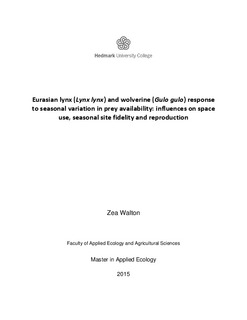Eurasian lynx ( Lynx lynx ) and wolverine ( Gulo gulo ) response to seasonal variation in prey availability: influences on space use, seasonal site fidelity and reproduction
Master thesis

Åpne
Permanent lenke
http://hdl.handle.net/11250/285506Utgivelsesdato
2015Metadata
Vis full innførselSamlinger
Sammendrag
In systems with migratory prey, resource availability varies seasonally and can modify the spatialorganization of carnivores. Pred ators within these systems must therefore adopt a strategy to deal with prey movements when resources are seasonally unavailable. The seasonal migration of semidomesticated reindeer (Rangifer tarandus) in northern Norway creates large temporal variation in prey availability for carnivores in this area. In this study, I investigate the response of Eurasian lynx (Lynx lynx) and wolverine (Gulo gulo) to seasonal reindeer migration in Finnmark and Troms counties, Norway. I examine the space use of these solitary carnivores in two areas: one with migratory reindeer (Finnmark) and another with seasonally stable reindeer availability (Troms). I use GPS data to examine seasonal home range overlap and centroid shift distances to investigate how temporally changing prey abundance influences carnivore space use. I further investigate the influence of reindeer availability on lynx
reproduction and recruitment rates. Lynx and wolverine largely maintained stable residency, even within a system of migratory prey. Mean proportion of seasonal home range overlap for lynx and wolverine was >50% for all individuals. Male lynx showed a higher degree of home range stability than females while wolverines showed no intersexual differences. When reindeer were not seasonally available, most
individuals exhibited directional home range overlap suggesting that winter home range expansion is necessary to obtain adequate food resources. In both species, females exhibited greater winter home range expansion and shift distances. Contrary to expectations, some carnivores that overlapped winter reindeer grazing areas showed less stability than either those that were completely lacking winter reindeer or those that had stable reindeer presence year around. This was evident in both lynx and wolverine. Female lynx showed restricted range use in summer, related to denning behavior, while
reproduction increased winter home range expansion in females. However, reproduction was not influenced by winter reindeer availability. Recruitment was lower in areas without winter reindeer presence (20%) than in areas with reindeer (47%) indicating that winter reindeer availability may influence kitten survival. The results of this study indicate that the decreased lynx recruitment seen may be related to the costs of living within a system with seasonally marginal resources. Further research is needed
investigating a link between foraging behavior and demographic processes in lynx. Overall, my findings suggest that the space use of carnivores in areas of predictable reindeer presence is more stable than carnivores with seasonal variation in prey availability. It may be important to consider the effect of seasonal resource distribution on carnivore demography and overall spatial stability in population management planning as well.
Beskrivelse
Masterin applied ecology. Evenstad 2015